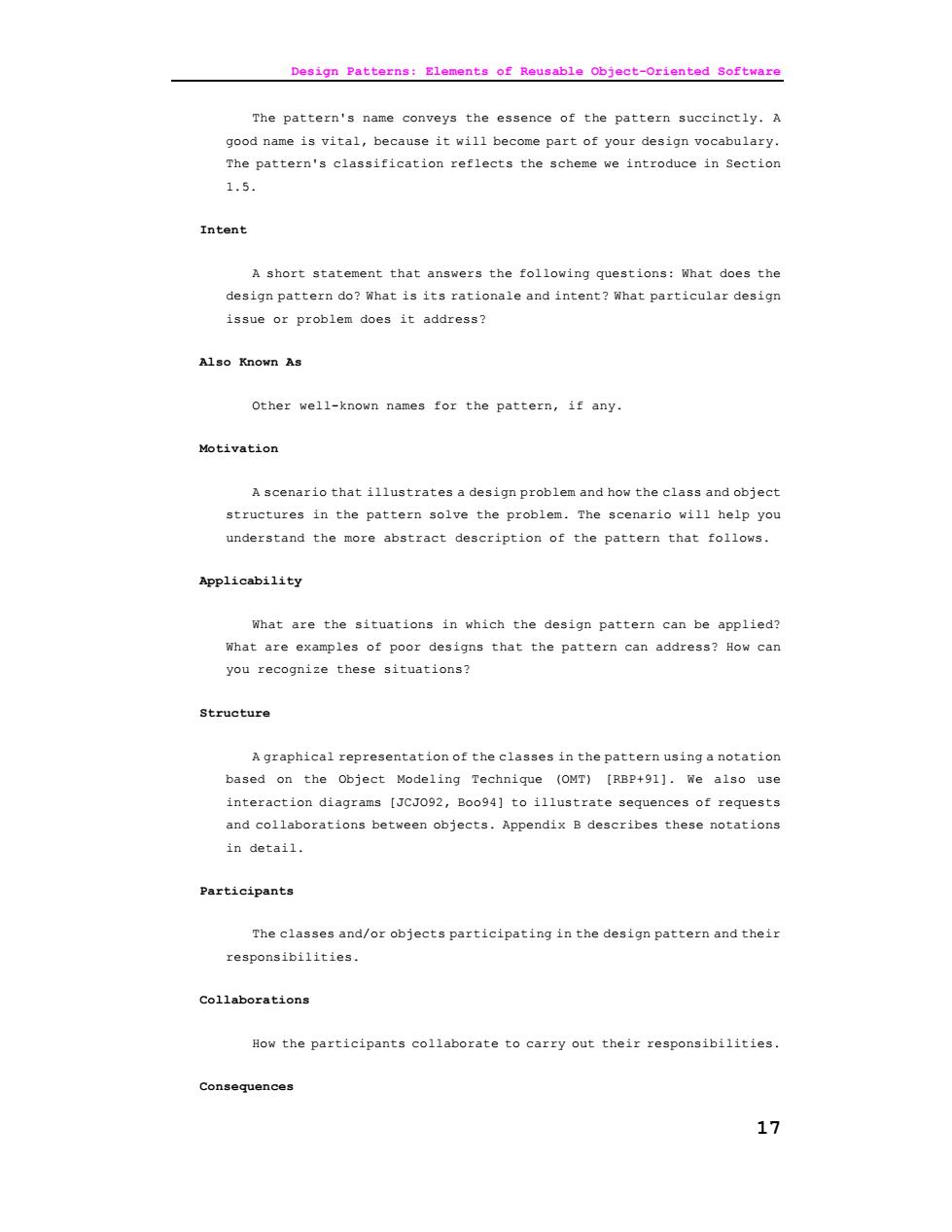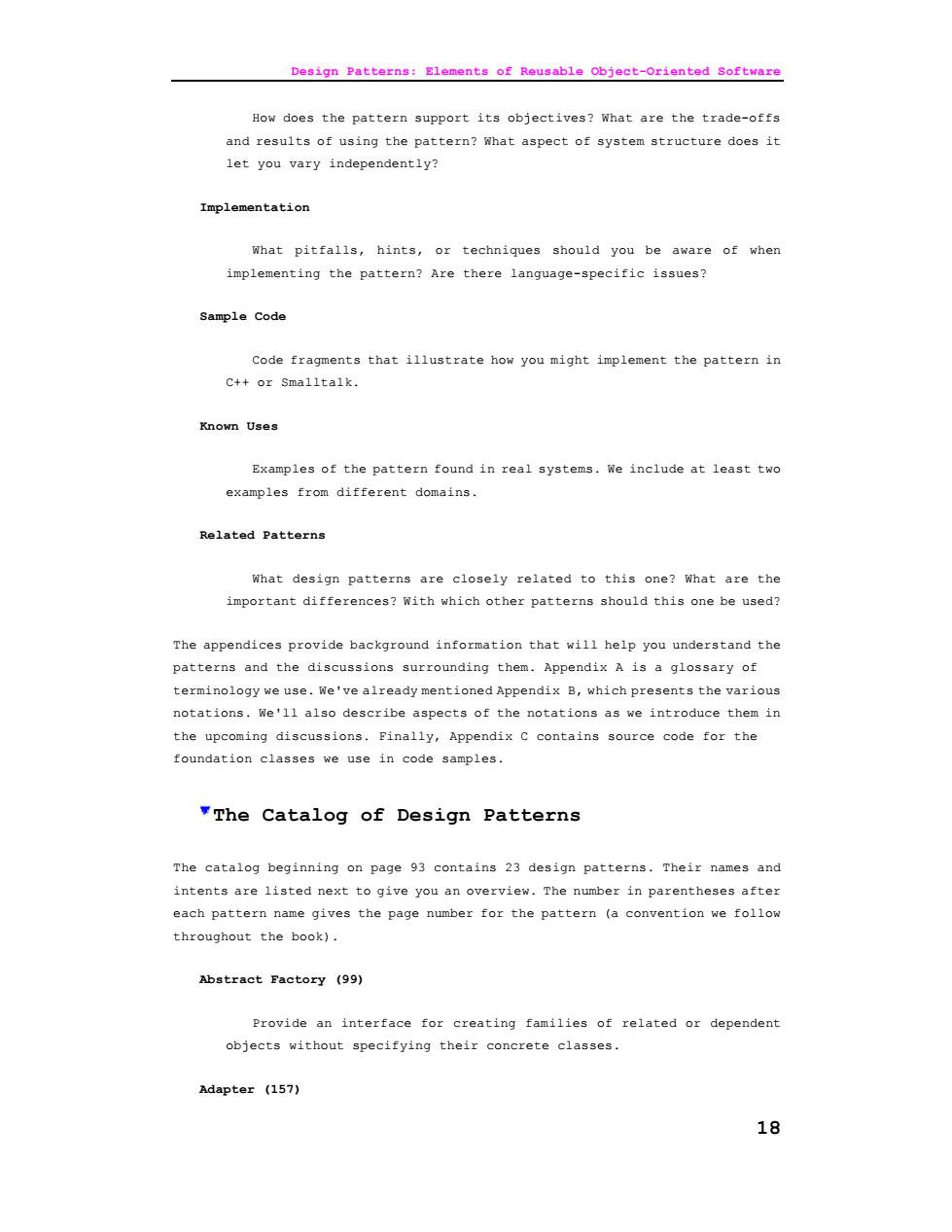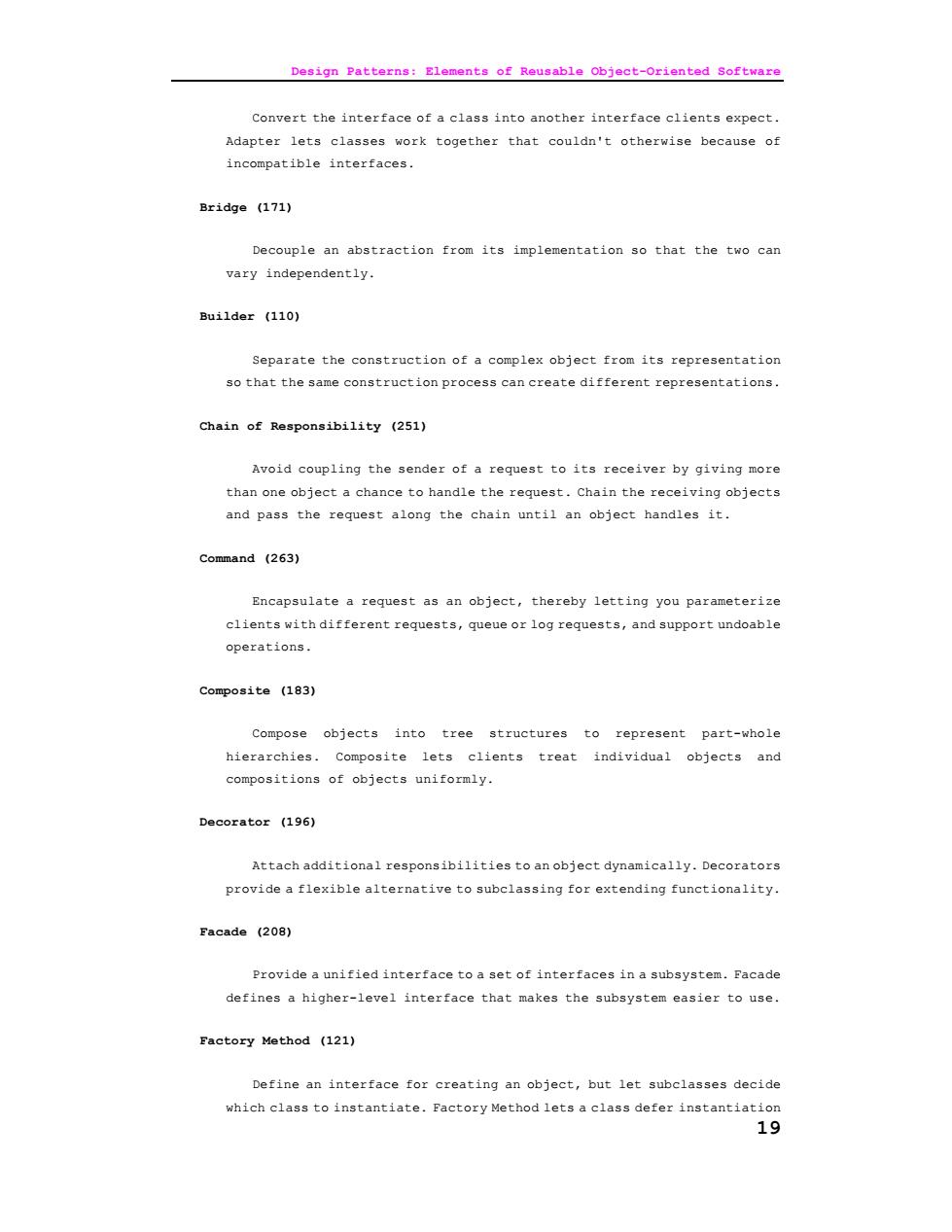
Design Patterns:Elements of Rousable Object-Oriented Software The pattern's name conveys the essence of the pattern succinctly.A good name is vital,because it will be come part of your design vocabulary. The pattern's classification reflects the scheme we introduce in Section 1.5. Intent A short statement that answers the following questions:What does the design pattern do?what is its rationale and intent?What particular design issue or problem does it address? Also Known As Other well-known names for the pattern,if any. Motivation A scenario that illustrates a design problem and how the class and object structures in the pattern solve the problem.The acenario will help you cription of the pattern that follows Applicability What are the situations in which the design pattern can be applied? What are examples of poor designs that the pattern can address?How can you recognize these situations? structure Agraphical representation of the classes in the based on the Object Modeling Technique (OMT)[RBP+91].We also use interaction diagrams [JCJO92,Boo94]to illustrate sequences of requests and collaborations between objects.Appendix B describes these notations in detail. Participants The classes and/or objects participating in the design pattern and their Collaborations How the participants collaborate to carry out their responsibilities. Consequences 17
Design Patterns: Elements of Reusable Object-Oriented Software 17 The pattern's name conveys the essence of the pattern succinctly. A good name is vital, because it will become part of your design vocabulary. The pattern's classification reflects the scheme we introduce in Section 1.5. Intent A short statement that answers the following questions: What does the design pattern do? What is its rationale and intent? What particular design issue or problem does it address? Also Known As Other well-known names for the pattern, if any. Motivation A scenario that illustrates a design problem and how the class and object structures in the pattern solve the problem. The scenario will help you understand the more abstract description of the pattern that follows. Applicability What are the situations in which the design pattern can be applied? What are examples of poor designs that the pattern can address? How can you recognize these situations? Structure A graphical representation of the classes in the pattern using a notation based on the Object Modeling Technique (OMT) [RBP+91]. We also use interaction diagrams [JCJO92, Boo94] to illustrate sequences of requests and collaborations between objects. Appendix B describes these notations in detail. Participants The classes and/or objects participating in the design pattern and their responsibilities. Collaborations How the participants collaborate to carry out their responsibilities. Consequences

Design Patterns:glemente of Reusable Object-Oriented Software How does the pattern support its objectives?What are the trade-ofts and results of using the pattern?What aspect of system structure does it let you vary indep ndentiy What pitfalls,hints,or techniques should you be aware of wher implementing the pattern?Are there language-specific issues? Sample Code Code fragments that illustrate how you might implement the pattern in C++or Smalltalk. Known Uses Examples of the pattern found in real systems.We include at least two examples from different domains. Related Patterns What design patterns are closely related to this one?What are the important differences?Nith which other patterns should this one be used? The appendices provide background information that will help you understand the patterns and the discussions surrounding them.Appendix A is a glossary of terminology we use.We've already mentioned Appendix B,which presents the various notations.We'11 also describe aspects of the notations as we introduce them in the upcoming discussions.Finally,Appendix c contains source code for the foundation classes we use in code samples. The Catalog of Design Patterns The catalog beginning on page 93 contains 23 design patterns.Their names and intents are listed next to give you an overview.The number in parentheses after each pattern name gives the page number for the pattern (a convention we follow throughout the book). Abatract Factory (99) Provide an interface for creating families of related or dependent objects without specifying their concrete classes. Adapter (157) 18
Design Patterns: Elements of Reusable Object-Oriented Software 18 How does the pattern support its objectives? What are the trade-offs and results of using the pattern? What aspect of system structure does it let you vary independently? Implementation What pitfalls, hints, or techniques should you be aware of when implementing the pattern? Are there language-specific issues? Sample Code Code fragments that illustrate how you might implement the pattern in C++ or Smalltalk. Known Uses Examples of the pattern found in real systems. We include at least two examples from different domains. Related Patterns What design patterns are closely related to this one? What are the important differences? With which other patterns should this one be used? The appendices provide background information that will help you understand the patterns and the discussions surrounding them. Appendix A is a glossary of terminology we use. We've already mentioned Appendix B, which presents the various notations. We'll also describe aspects of the notations as we introduce them in the upcoming discussions. Finally, Appendix C contains source code for the foundation classes we use in code samples. The Catalog of Design Patterns The catalog beginning on page 93 contains 23 design patterns. Their names and intents are listed next to give you an overview. The number in parentheses after each pattern name gives the page number for the pattern (a convention we follow throughout the book). Abstract Factory (99) Provide an interface for creating families of related or dependent objects without specifying their concrete classes. Adapter (157)

Design Patterns:Elements of Rousable Objact-Orientod Software Convert the interface of a class into another interface clients expect Adapter lets classes work together that couldn't otherwise because of incompatible interfaces Bridge (171) Decouple an abstraction from its implementation so that the two can vary independently. Builder (110) Separate the construction of a complex object from its representatior so that the same construction process can create different representations. Chain of Responsibility (251) Avoid coupling the sender of a request to its receiver by giving more than one object a chance to handle the request.Chain the receiving objects and pass the reguest along the chain until an obiect handles it. Command (263) Encapsulate a request as an object,thereby letting you parameterize clients with different requests,queue or log requests,and support undoable operations. Composite (183) Compose objects into tree structures to represent part-whole hierarchies. Composite lets clients treat individual objects and compositions of objects uniformly. Decorator (196) Attach additional responsibilities to an object dynamically.Decorators provide a flexible alternative to subclassing for extending functionality. Facade (208) Provide a unified interface to a set of interfaces in a subsystem.Facade defines a higher-level interface that makes the aubsystem easier to use Factory Method (121) Define an interface for creating an object,but let subclasses decide which class to instantiate.Factory Method lets a class defer instantiation 19
Design Patterns: Elements of Reusable Object-Oriented Software 19 Convert the interface of a class into another interface clients expect. Adapter lets classes work together that couldn't otherwise because of incompatible interfaces. Bridge (171) Decouple an abstraction from its implementation so that the two can vary independently. Builder (110) Separate the construction of a complex object from its representation so that the same construction process can create different representations. Chain of Responsibility (251) Avoid coupling the sender of a request to its receiver by giving more than one object a chance to handle the request. Chain the receiving objects and pass the request along the chain until an object handles it. Command (263) Encapsulate a request as an object, thereby letting you parameterize clients with different requests, queue or log requests, and support undoable operations. Composite (183) Compose objects into tree structures to represent part-whole hierarchies. Composite lets clients treat individual objects and compositions of objects uniformly. Decorator (196) Attach additional responsibilities to an object dynamically. Decorators provide a flexible alternative to subclassing for extending functionality. Facade (208) Provide a unified interface to a set of interfaces in a subsystem. Facade defines a higher-level interface that makes the subsystem easier to use. Factory Method (121) Define an interface for creating an object, but let subclasses decide which class to instantiate. Factory Method lets a class defer instantiation

Design Patterns:Elements of Rousable Object-Oriented Software to subclasses Flyweight (218) Use sharing to support large numbers of fine-grained objecta efficiently. Interpreter(274) Given a language,define a represention for its grammar along with an interpreter that uses the representation to interpret sentences in the language Iterator (289) Provide a way to access the elements of an aggregate object sequentially without exposing its underlying representation. Medsator (305) Define an object that encapsulates how a set of objects interact. Mediator promotes loose coupling by keeping objects from referring to each other explicitly,and it lets you vary their interaction independently. Memento (316) Without violating encapsulation,capture and externalize an object's internal state so that the object can be restored to this atate later. Observer (326) Define a one-to-many dependency between objects so that when one object changes state,all its dependents are notified and updated automatically. Prototype (133) Specify the kinds of objects to create using a prototypical instance and create new objects by copying this prototype. Proxy (233) Provide a surrogate or placeholder for another object to control access to it singleton(144) 20
Design Patterns: Elements of Reusable Object-Oriented Software 20 to subclasses. Flyweight (218) Use sharing to support large numbers of fine-grained objects efficiently. Interpreter (274) Given a language, define a represention for its grammar along with an interpreter that uses the representation to interpret sentences in the language. Iterator (289) Provide a way to access the elements of an aggregate object sequentially without exposing its underlying representation. Mediator (305) Define an object that encapsulates how a set of objects interact. Mediator promotes loose coupling by keeping objects from referring to each other explicitly, and it lets you vary their interaction independently. Memento (316) Without violating encapsulation, capture and externalize an object's internal state so that the object can be restored to this state later. Observer (326) Define a one-to-many dependency between objects so that when one object changes state, all its dependents are notified and updated automatically. Prototype (133) Specify the kinds of objects to create using a prototypical instance, and create new objects by copying this prototype. Proxy (233) Provide a surrogate or placeholder for another object to control access to it. Singleton (144)

Design Patterns:Elements of Rousable Object-Oriented Software Ensure a class only has one instance,and provide a global point of access to it state (338) Allow an object to alter its behavior when its internal state changes. The object will appear to change its class. strategy (349) Define a family of algorithms,encapsulate each one,and make them interchangeable.Strategy lets the algorithm vary independently from clients that use it. Template Method (360) Define the skeleton of an algorithm in an operation,deferring some steps to subclasses.Template Method lets subclasses redefine certain steps of an algorithm without changing the algorithm's structure. visitor (366) Represent an operation to be performed on the elements of an objec structure.Visitor lets you define a new operation without changing the classes of the elements on which it operates. YOrganizing the Catalog Design patterns vary in their granularity and level of abstraction.Because there are many design patterns,we need a way to organize them.This section classifies design patterns so that we can refer to families of related patterns.The classification helps you learn the patterns in the catalog faster,and it can direct efforts to find new patterns as well. We classify design patterns by two criteria (Table 1.1).The first criterion, called purpose,rerlects what a pattern does.Patterns can have either creational, struetural,or behavioral purpose.Creational patterns concern the process of object creation.Structural patterns deal with the composition of classes or objects.Behavioral patterns characterize the ways in which classes or objects interact and distribute responsibility. Purpose reational Structural Behavioral 21
Design Patterns: Elements of Reusable Object-Oriented Software 21 Ensure a class only has one instance, and provide a global point of access to it. State (338) Allow an object to alter its behavior when its internal state changes. The object will appear to change its class. Strategy (349) Define a family of algorithms, encapsulate each one, and make them interchangeable. Strategy lets the algorithm vary independently from clients that use it. Template Method (360) Define the skeleton of an algorithm in an operation, deferring some steps to subclasses. Template Method lets subclasses redefine certain steps of an algorithm without changing the algorithm's structure. Visitor (366) Represent an operation to be performed on the elements of an object structure. Visitor lets you define a new operation without changing the classes of the elements on which it operates. Organizing the Catalog Design patterns vary in their granularity and level of abstraction. Because there are many design patterns, we need a way to organize them. This section classifies design patterns so that we can refer to families of related patterns. The classification helps you learn the patterns in the catalog faster, and it can direct efforts to find new patterns as well. We classify design patterns by two criteria (Table 1.1). The first criterion, called purpose, reflects what a pattern does. Patterns can have either creational, structural, or behavioral purpose. Creational patterns concern the process of object creation. Structural patterns deal with the composition of classes or objects. Behavioral patterns characterize the ways in which classes or objects interact and distribute responsibility. Purpose Creational Structural Behavioral